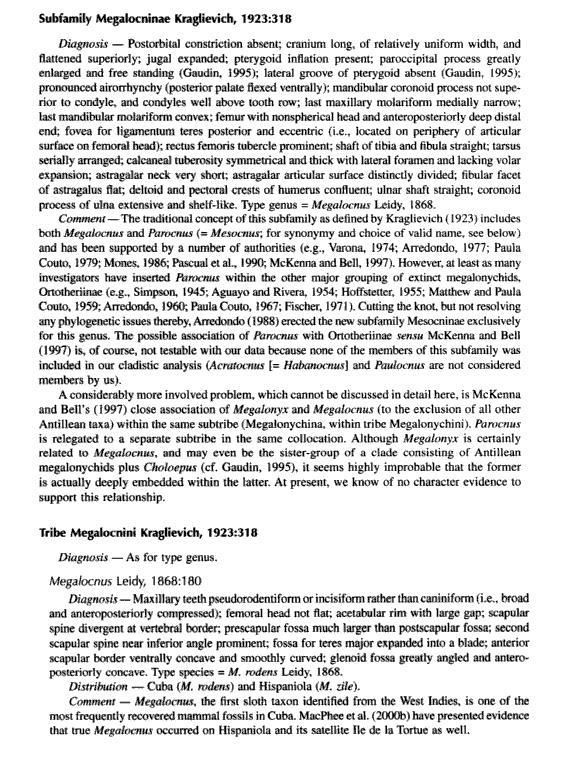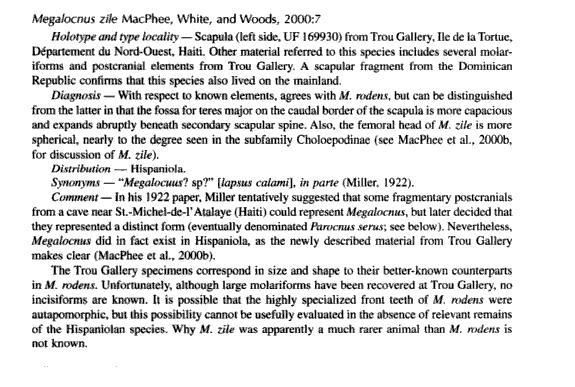|
|
Post by another specialist on Jun 21, 2008 21:29:16 GMT
|
|
|
|
Post by another specialist on Jun 22, 2008 15:47:46 GMT
New Megalonychid Sloths (Phyllophaga, Xenarthra) from the Quaternary of Hispaniola R.D.E. MacPHEE, JENNIFER L. WHITE, and CHARLES A. WOODS As part of ongoing revisionary work on Antillean Megalonychidae, we document four new sloth species from Quaternary cave localities in Haiti and the Dominican Republic.* The new taxa and their tribal affiliations are as follows: Megalocnus zile (Megalocnini), Acratocnus ye (Acratocnini), and Neocnus dousman and N. toupiti (Cubanocnini). Significantly, each is closely related to species in genera long known from Cuba. This observation is of primary biogeographical importance because the most parsimonious explanation for the presence of parallel arrays of lower-level clades of sloths on opposite sides of the Windward Passage is vicariance, not a series of uncoordinated over-water dispersals. For a brief period in the late Paleogene, eastern Cuba, northern Hispaniola, Puerto Rico, and the Aves Rise formed a large positive structure (GAARlandia) that was evidently briefly continuous with northwestern South America. We infer that the later subdivision and subsidence of major portions of GAARlandia must have finely vicariated its biota (which included sloths at least as early as the Early Oligocene). On this argument, Megalocnus, Acratocnus, Neocnus, and Parocnus (= Mesocnus) must have already been in existence as independent clades at the time of origin of the Windward Passage (early Neogene), because cladistically diagnosable members of these taxa occur in Quaternary contexts in both Cuba and Hispaniola. This interpretation is consistent with several new lines of evidence concerning the paleontological and paleogeographical history of the Caribbean region. www.bioone.org/perlserv/?request=get-document&doi=10.1206%2F0003-0082(2000)3303%3C0001%3ANMSPXF%3E2.0.CO%3B2&ct=1 |
|
|
|
Post by another specialist on Jun 22, 2008 18:19:06 GMT
  Biogeography of the West Indies: Patterns and Perspectives By Charles A. Woods, Florence E. Sergile |
|
|
|
Post by another specialist on Jun 25, 2008 7:44:27 GMT
Hispaniola. Although several Holocene "whole bone" 14C dates have been reported for Haitian cave sites (40–42), these dates were not necessarily tied to individual taxa. For sloths, this task would have been difficult in do in any event, because Hispaniolan sloths were not revised systematically until recently (5). Nevertheless, a single "whole-bone" date (8,120 ± 216 yr BP) on an assortment of sloth bones (42) provided the first evidence that phyllophagans had persisted into the Holocene on that island. Here, we report nine previously undescribed AMS 14C dates (Table 4) on sloth bones identified to species, all from limestone caves and sinkholes on the Haitian side of Hispaniola. Three of the seven sites are in the Massif de la Selle in southeastern Haiti; another three are on the Plain Formon of the Tiburon Peninsula (41). The seventh site, Trouing Gallery, is on Ile de la Tortue, 7.5 km off Haiti's northern coast. As in Cuba, none of the dated Haitian sloth bones is associated with cultural features or artifacts. www.pnas.org/cgi/content/full/102/33/11763 |
|
|
|
Post by another specialist on Jul 28, 2008 21:19:07 GMT
|
|
|
|
Post by another specialist on Jul 28, 2008 21:41:51 GMT
|
|